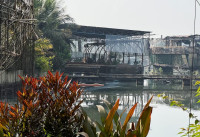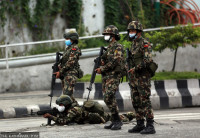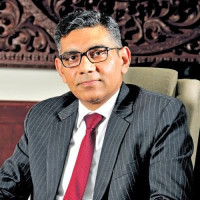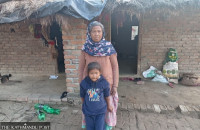National
What does Nepal’s Vice President do? Nothing
Since the constitution does not provide any substantial role for the Office of the Vice President, it has by and large become an idle institution, experts say.
Tika R Pradhan
Over the past few weeks, the country has been endlessly debating KP Sharma Oli’s decision to dissolve the House of Representatives and President Bidya Devi Bhandari’s promptitude to approve it and whether the move is constitutional, whether the Speaker can revive the house, whether the House will be restored by the Supreme Court, and whether the declared elections will take place if the Supreme Court endorses the government's move.
Oli’s move of dissolving the House has raised some serious questions and dragged all the branches of a democratic government—the judiciary, the executive and the legislature—as well as the Office of the President into a highly-charged debate.
But there is one office, which is also envisioned by the constitution, that has failed to draw anyone’s attention. And many wonder why this office was instituted and what exactly it does.
It is the Office of the Vice President.
The last time Vice President Nanda Bahadur Pun got a mention in the media was on Tuesday when he extended greetings on the occasion of Tamu Lhosar, days after he extended similar greetings on Christmas Day.
Experts and political party leaders say it is not clear why exactly the drafters of the constitution decided to create the Vice President position when the country transitioned into a federal republic in 2008.
“As a matter of fact, the Vice President in Nepal barely has any role in the current constitutional set-up,” said Chandra Kanta Gyawali, who specialises in constitutional law.
Article 67 of the Constitution of Nepal 2015 says: There shall be a Vice-president of Nepal.”
Its Clause 2 says the Vice-President shall perform the duties of the President until a new President is elected in the case when the President ceases to hold office due to reasons other than when the President is absent or the term of office has expired.
But Nepal’s Vice President so far has not got a single opportunity to perform any duty.
Even the country’s first Vice President Paramananda Jha had raised his concerns from the public forums about not having any role.
Jha was elected to the second highest office in the country along with the country's first President Ram Baran Yadav in 2008.
“I had repeatedly talked about my role when I was the Vice President so as to convince leaders that they should provision some role for the Vice President in the constitution,” Jha told the Post over the phone. “I don’t know how the new Vice President feels about it.”
The drafters of the 2015 constitution may have taken inspiration from the Indian constitution, which has envisioned a Vice President.
But the Indian constitution has defined a role for the Vice President.
Articles 64 and 89 (1) of the Constitution of India states that the Vice President of India shall be ex officio chairman of the Council of States or Rajya Sabha.
The Office of the Vice President is considered one of the unique features of the Indian constitution, as there is no exact parallel in the countries of other democratic constitutions of the world.
The only constitution, among the important democracies of the world, which provisions such an office is that of the United States of America. But the United States has a presidential system of government and not a parliamentary one.
Nepal’s parliamentary system is analogous to that of India and the United Kingdom, but the latter is a monarchy.
In India, the Vice President has a dual role to perform—as the second head of the executive and as the presiding officer of the upper house of Parliament.
“Lawmakers and legal experts had suggested that the drafters of the constitution should envision some role for the Vice President—chairperson of the National Assembly,” Gaywali told the Post. “But our suggestions were ignored.”
After Jha, Pun was elected the Vice President in October 2015. Then again in 2018, he was re-elected to the post along with Bidya Devi Bhandari as the President—both representing the then Maoist Centre and then CPN-UML.
“The Vice President’s main role is to protect the constitution. He is obviously not satisfied with having no role to play as such but that’s how the constitution has defined his role,” said Manoj Gharti Magar, press coordinator for Vice President Pun. “Yes, we have heard about some discussion about expanding the Vice President’s role.”
When discussions to formulate the Higher Education Bill were taking place at the Education Ministry, there were suggestions for making the Vice President the chancellor of some selected universities, changing the existing provision of prime minister being the chancellor.
During the tenure of the first Constituent Assembly (from 2008 to 2012), a task force was formed under the constitution drafting committee led by top leaders including Agni Kharel, Radheshyam Adhikary, Sapana Malla, Laxman Lal Karna and Khimlal Devkota.
“The task force had suggested that the Vice President should be made the chairperson of the upper house, but leaders ignored the suggestion,” said Devkota, a senior advocate and one of the members of the committee. “The only job of our Vice President has been to attend functions organised by some foreign missions during their respective national days.”
Devkota, who is also the central member of the Nepal Communist Party, said if the Office of the Vice President is to be kept, the constitution must provide proper responsibilities for the Vice President.
Though the constitution says the Vice President performs the duties of the President in the latter’s absence, no such opportunity has ever come for the Office of the Vice President in the last 12 years.
According to sources at the Office of the Vice President, the President has travelled about half a dozen times since October 2015, but not even once has the Vice President got any responsibility.
“Even a bill endorsed by the federal parliament some three years ago when the President was on a foreign visit was delayed until she returned,” said an official who did not wish to be named. “I think they [the President and the prime minister] don’t want the Vice President to work.”
Some say the Office of the Vice President in Nepal literally has no job to do but the state continues to spend money from its coffers on the institution.
Former Vice President Jha shared his experience in the office, saying his job was just to look at Sheetal Niwas.
“There was just this feeling that there was something, which actually meant nothing, when the President was abroad,” Jha told the Post. “Even when the President goes abroad, the government authorities do not trust the Vice President.”
According to Jha, if the constitution has elected someone to the second highest position, it must provide some responsibilities to that person.
“It doesn’t look good that the second highest ranking person has no job and the state has to spend resources on that person,” said Jha. “I had once even said publicly that the Office of the Vice President should be scrapped.”
Karna, who was a member of a task force to provide suggestions to the constitution drafting committee, said leaders refused to have a provision of making the Vice President the chair of the upper house.
According to Karna, the leaders believed that it would be too small a position for the Vice President if he or she were asked to preside over the upper house.
“I believe the person who holds that office must be feeling humiliated,” said Karna. “We need to start a debate whether we need such an office and if it is needed, the current provisions must be changed so as to provide some role for the office holder.”




 16.12°C Kathmandu
16.12°C Kathmandu













%20(1).jpg&w=300&height=200)

